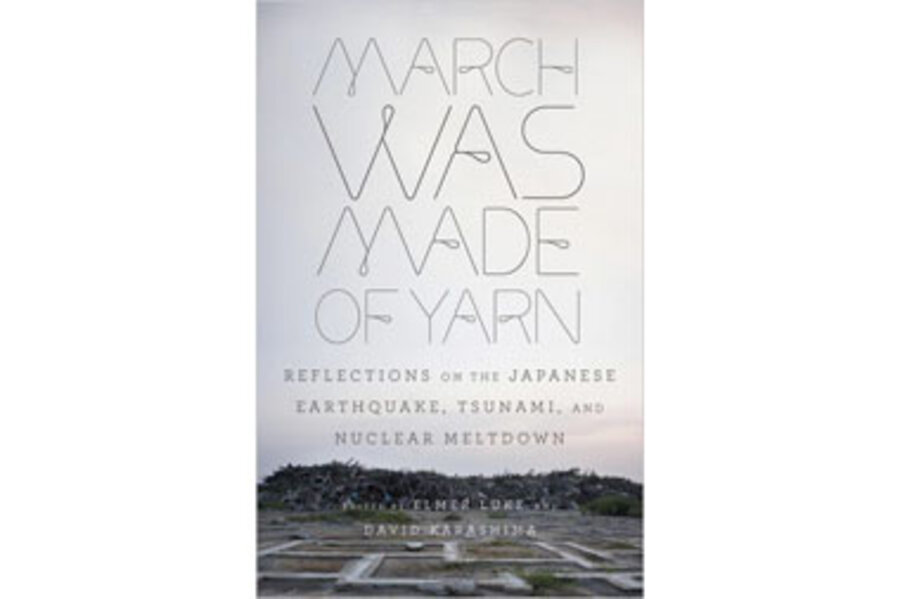March Was Made of Yarn
Loading...
March 11, 2011, 14:46 Japan Standard Time: A magnitude-9.0 earthquake lasts six minutes, followed by a 50-foot tsunami that, within 15 minutes, plows inland six miles and causes meltdowns in five nuclear plants. “In one’s wildest imagination, this is beyond conceivable,” write editors Elmer Luke and David Karashima in their introduction to March Was Made of Yarn.
One year later, writer/editor Luke and novelist/translator Karashima have pulled together a diverse collection of new and previously published nonfiction, fiction, poetry, and a manga to create “an artistic record” of a people’s response to an unimaginable disaster. The writers are mostly Japanese – including major names like Yoko Ogawa and Ryu Murakami – translated into English by an impressive list of powerhouse translators. Although the quality of the final product is mixed – as is often the case with anthologies – the impetus behind each individual piece is heartfelt.
Two stories are standouts, each for the naked vulnerability they display. In “The Charm,” by Kiyoshi Shigematsu (translated by Jeffrey Hunter), a woman plagued by guilt for “her comfortable, carefree life in Tokyo” returns to a town “devoured by the ocean” where she spent a year of her peripatetic childhood, hoping to contact any of her former classmates. Her search takes her to a hilltop playground where she witnesses two young girls sharing a “charm” – a chanted promise – so personal that it makes her feel that “now everything was all right.”
In Shinji Ishii’s “Lulu” (translated by Bonnie Elliott), a nocturnal dog who lives in a “municipal children’s facility” watches “translucent women” magically bestow “the gift of rest” to children traumatized by disaster. Lulu, who has led the cruel life of an unwanted dog, empathizes with five children unattended by the magical women; one by one, with the sheer unconditional love that only dogs can offer, she “pull[s] each of them out of darkness and back into the land of peaceful sleep.” Twelve years later, 32 of the children gather for a reunion at which Lulu is named and remembered.
Many of the other pieces, if not as memorable, share powerfully resonating moments. In Yoko Tawada’s “The Island of Eternal Life” (translated by Margaret Mitsutani), devoted doctors in an isolated futuristic Japan “gather swarms of fireflies” to create light in order to continue their saving work after dark. In Hiromi Kawakami’s “God Bless You, 2011” (translated by Ted Goosen and Motoyuki Shibata) – an updated version of his 1993 story – a man decides that hugging his bear-friend is more important than being exposed to any radiation trapped in the bear’s fur. In Natsuki Ikezawa’s “Grandma’s Bible” (translated by Alfred Birnbaum), a man gives up a potentially easier life in the United States to help rebuild his late brother’s leveled town where “Grandma’s Bible is still somewhere here on the ocean floor.”
Of the three non-Japanese pieces, British expat novelist David Peace’s “After the Disaster, Before the Disaster” is the most enigmatic. After surviving the 1923 Great Kanto earthquake (which previously had been considered Japan’s worst quake), Ryunosuke (identified as iconic writer Akutagawa Ryunosuke by a reference to his death four years later) wanders Tokyo searching for his friend Yasunari (a stand-in for Kawabata, another canonic Japanese writer). Joined by friend in common Kon (presumably Ichikawa, the famed filmmaker, who would have been a mere boy then), the trio bears witness to horrifying destruction.
Together these pieces depict the struggle of a people to find meaning after so great a tragedy. The book’s title is taken from a story by Mieko Kawakami (translated by Michael Emmerich). Kawakami writes of a pregnant woman who shares with her husband a dream she has about “a world where everything was made of yarn.” Cups, clothes, books made of yarn don’t seem too strange, but when she insists that “even March was made of yarn,” her husband can’t understand how “a name we give to a segment of time” could be made of yarn. His struggle for meaning mirrors our own efforts to grasp that which is incomprehensible.
“Words grown old from overuse ... grow toward new meanings,” writes Shuntaro Tanikawa (translated by Jeffrey Angles) in his epigraphic poem “Words.” Indeed, the words that follow reclaim and redefine one of history’s most unfathomable disasters. One by one, the writers here “reconceive the catastrophe, imagine a future and a past, interpret dreams, impel purpose, point blame, pray for hope.”
Terry Hong writes BookDragon, a book review blog for the Smithsonian Asian Pacific American Program.








